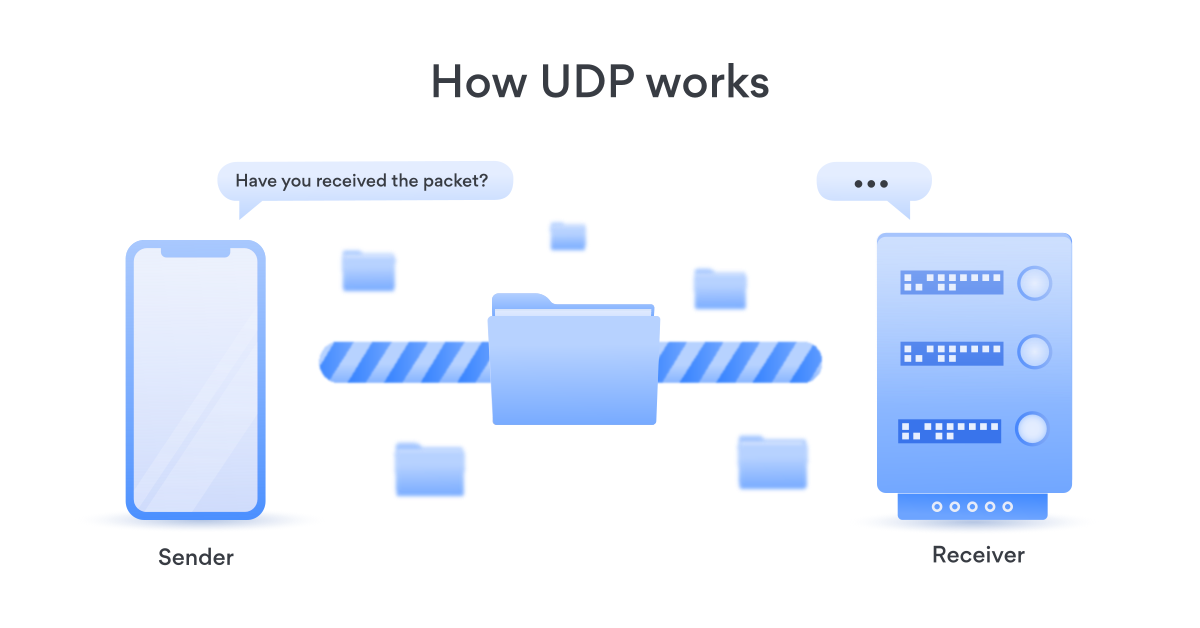FTC disclaimer: This post contains affiliate links and I will be compensated if you make a purchase after clicking on my link.
What is the difference between TCP and UDP? Why do we care?
This is a question that often comes up in networking courses. It turns out that the answer is pretty simple. It’s just a matter of how many bits of information you send over the network.
This article will explain the difference between UDP and TCP ports and why knowing this information is important. It will also help you understand how to find out what type of port your website uses.
What is TCP?
Transmission Control Protocol (TCP), the standard Internet transport layer protocol, is connection-oriented, which means that once a connection has been set up, data can be transferred in both directions.
This makes TCP the perfect protocol for sending large amounts of data, such as image files, video streams, and web pages.
However, because TCP is inherently reliable, it typically requires more bandwidth than alternative protocols.
For example, when you send an email containing a picture attachment, you probably use either SMTP or POP3/IMAP4 (depending on the type of mail client you use).
These protocols do not require a full connection before transmitting data; they establish a session and immediately begin sending data.
Because no handshake is required to start transmission, these protocols are much faster than TCP.
How does TCP work?
TCP stands for Transmission Control Protocol. This protocol allows computers to communicate over networks.
TCP works by establishing a connection between two communicating devices. It does this by sending packets of information.
The receiving device acknowledges it and sends another packet back when it receives a packet.
If the receiving device doesn’t acknowledge the packet, the transmitting device assumes something went wrong and reattempts to send the same packet. After several attempts, the connection is finally established.
Once the connection is established, the transmitter starts sending data. After each piece of data is sent, the receiver acknowledges receipt.
When the transmission is complete, the connection is closed by both parties sending a close frame.
What is UDP?
User Datagram Protocol (UDP) is a simple, connectionless Internet protocol.
It works similarly to TCP/IP except that it does not maintain connections between computers and therefore does not require handshaking or acknowledgments.
Instead, each packet of information is simply passed along to the next computer in sequence.
This makes it useful for real-time applications such as video conferencing, instant messaging, and online gaming.
Although UDP isn’t ideal for accessing webpages or downloading files, it is widely used for transmitting audio, video, and multimedia over networks.
Many modern voice communication protocols use UDP.
How does UDP work?
UDP stands for User Datagram Protocol. This protocol is used for sending messages over IP networks. It does not use TCP/IP handshake protocols like HTTP, SMTP, FTP, etc.
It doesn’t even require the sender and receiver to know each other. Instead, UDP just sends packets to the destination address specified in the header.
This makes UDP very useful for real-time applications where latency is critical. For example, video conferencing requires low latency because of the high bandwidth requirements associated with transmitting audio and video streams.
However, UDP is incompatible with reliable delivery, i.e., ensuring that lost or corrupted data are retransmitted. So, you cannot rely on UDP for long-distance communication.
A good way to understand how UDP works is to think about it as a stream of bits.
When you send a file via FTP, you start downloading the file from one place and stop once you reach the end. Similarly, when you download a web page, you download bytes sequentially from the server.
You don’t wait for the entire page to load before starting to read the next byte. If there is a problem during the transfer, the receiving computer might receive part of the file or none of it.
But since the file continues from where it left off, the receiving program knows exactly what data to process.
In contrast, UDP is similar to a continuous flow of water. Water flows continuously from source to sink whether we open our faucet or not.
There is no way to tell where the water ends, nor do we care. We simply want to move it from one location to another.
So, why do we still use TCP/IP? Because TCP/IP provides a lot of features that UDP lacks. These include reliability, sequencing, congestion control, and connection management.
With TCP/IP, we can ensure that every packet gets delivered reliably and in sequence. And we can use TCP/IP to manage connections between computers.
What is the Difference Between TCP and UDP?
TCP (Transmission Control Protocol) is a communication protocol used in computer networks that ensures reliable data transmission. This protocol uses checksums to ensure that the data is received correctly.
UDP (User Datagram Protocol) is similar to TCP. However, it does not provide reliability. So, it cannot guarantee the integrity of the data.
In addition, TCP provides guaranteed delivery, while UDP does not. With TCP, once the packet reaches the destination system, there is no way to know whether the packet reached the destination successfully or not.
However, even if the packet fails to reach the destination with UDP, it will not affect the overall performance.
However, both protocols are used together. For example, web browsers communicate with servers via TCP/IP and send requests to the server via HTTP. Similarly, email clients use TCP/IP to connect to mail servers and send emails.
TCP vs. UDP: Header Comparison
TCP and UDP transport layer protocols operate above the Internet Protocol (IP).
However, they differ in how they handle packet loss and congestion control. TCP is designed to provide reliable transmission over unreliable networks like the internet, whereas UDP does not.
The TCP header comprises four fields: source port, destination port, sequence number, and acknowledgment number.
The Source port represents the local IP address, and the destination port represents the remote IP address.
The sequence number indicates the position of a given byte within the stream of bytes being transmitted. ACK indicates whether the receiving end acknowledges receipt of the current segment.
UDP, on the other hand, supports simpler communications between hosts.
The UDP header consists of three fields: source IP address, destination IP address, and length. The length field indicates the size of the packet in bytes.
TCP vs. UDP: Reliability Comparison
TCP is the most widely used network layer transport protocol. It provides reliable delivery, meaning every packet sent over a TCP connection will reach its destination.
This makes TCP very useful for web browsing, email, and voice communications applications. However, it does come with some drawbacks.
One of the main disadvantages of TCP is that it requires multiple round trips to deliver each packet, making it less efficient than UDP.
UDP is connectionless; it doesn’t require a full handshake process. Instead, it sends the packet immediately without waiting for a response.
This allows UDP to transmit data faster than TCP, but it lacks reliability because it won’t ensure that the packet reaches its destination. In addition, UDP is often unreliable.
For example, sending a file across the Internet might take several seconds for the file to arrive, even though the sender and receiver both use UDP.
The good news is that you don’t have to choose one or the other. You can combine the best features of both protocols.
For instance, you could use TCP for long connections and UDP for short ones. Similarly, you could use TCP to transfer large files and UDP for smaller messages reliably.
TCP vs. UDP: Congestion Comparison
Flow control is a mechanism that regulates the amount of information transmitted over networks. This process allows the sender to adjust the speed of sending data according to the receiver’s ability.
The Internet Protocol (IP) layer uses this technique to ensure that packets are delivered without being dropped.
However, some protocols do not use IP flow control. These include User Datagram Protocol (UDP), Transport Control Protocol (TCP), and Real Time Streaming Protocol (RTSP).
UDP does not control congestion, although it does implement congestion avoidance algorithms.
On the contrary, TCP controls congestion by adjusting the transmission speed based on the network’s capacity. TCP is responsible for ensuring that packets reach the destination within a certain period of time.
Additive-increase/multiplicative-decrease algorithm (AIMD) works as follows: First, the sender sends data at full speed.
Then, it increases the transmission speed by a factor of 2. If the receiving end accepts the data, the sender multiplies the transmission speed by 2.
Otherwise, the sender decreases the transmission speed by half. AIMD ensures that the transmission speed stays under a set threshold.
TCP vs. UDP: Ordering of messages
TCP (Transmission Control Protocol), used primarily for connecting hosts on the Internet, is responsible for ensuring the reliable delivery of messages.
It accomplishes this task by sending each piece of information in the correct order.
If you send a text packet to someone over the Internet, it must arrive in the same order it left your computer.
In addition, TCP guarantees that once a message is delivered, it will always be delivered exactly the same way.
On the other hand, UDP (User Datagram Protocol) is designed for applications where reliability isn’t important.
For example, many file transfer protocols use UDP because they don’t require guaranteed delivery. Instead, they just want to know whether the file arrived successfully.
The difference between TCP and UDP becomes apparent in how they handle retransmissions. When a network link breaks down, TCP automatically resends lost segments.
But UDP doesn’t do anything like this. The final result is the same as long as the destination machine receives every single one of the original packets.
TCP vs. UDP: Connection
TCP is a connection-oriented protocol. This means it requires three packets per connection.
These packets must be sent in order. If one packet gets lost, you lose the entire connection.
In addition, TCP uses acknowledgments to ensure reliable delivery. Acknowledgments require another round trip.
When there is congestion on the network, TCP slows down sending data because it needs to wait for ACKs to confirm the successful data transmission.
UDP is a connectionless protocol. You send a single datagram across the wire without waiting for confirmation.
Because of this, UDP does not use acknowledgments. Instead, it relies on retransmissions to detect the loss of packets. Retransmission is expensive in terms of bandwidth usage.
This makes UDP unsuitable for real-time applications such as VoIP, where latency is critical.
TCP vs. UDP: Data Transmissions
UDP continues to be a staple in internet communications. Despite its inherent unreliability, it is ideal for real-time data transmissions, such as voice over IP (VoIP), video conferencing, gaming, and file sharing applications.
Many of today’s popular online games use UDP exclusively, including Fortnite, World of Warcraft, League of Legends, Counter Strike Global Offensive, PlayerUnknown’s Battlegrounds, Call of Duty, and Minecraft.
In addition, UDP is often used for real-time traffic monitoring, such as network intrusion detection systems (NIDS).
These devices collect information about network activity and alert administrators when something suspicious occurs. As a result, UDP is widely used in industrial settings, too.
However, there are some drawbacks to UDP. First, it is best suited for short bursts rather than long data streams.
To transfer large amounts of data, you must use TCP. Second, UDP doesn’t guarantee delivery.
So, if you use UDP to transmit a file, you won’t know whether the recipient received it. Finally, UDP is less reliable than TCP.
If one of your packets gets dropped, UDP will simply resend it. But the entire session will fail if a packet is lost during a TCP conversation.
TCP vs. UDP: Error Detection
UDP does not support error detection. When data is sent over UDP, it is assumed that the sender knows what he/she is doing. The receiver receives corrupted packets if there are errors in the transmitted data.
The best way to detect such errors is to add a checksum to each byte of information you send. A checksum is simply a number calculated based on the bits of the original bytes.
For example, if a file contains 1024 bytes, the sum of those 1024 bytes is added. The resulting number is called the checksum.
Checksums allow receivers to verify whether the data they receive is valid without reading every single byte.
If the receiver detects an invalid checksum, it immediately discards the packet and sends a request to the sender, asking him/her to resend the data.
In contrast, TCP uses error detection and correction. Error detection allows the receiver to determine whether or not the data received is valid. Error correction enables the receiver to correct the errors found in the data.
TCP uses three different types of messages to accomplish this task. These include ACK, NAK, and RST.
ACK stands for acknowledging. An ACK message indicates that the receiver has successfully received the data. In addition, the receiver can ask the sender to re-transmit the same data.
NAK stands for negative acknowledgment. A NAK message indicates that the receiver did not receive the data. However, the receiver cannot tell why the data wasn’t received. To solve this problem, the receiver asks the sender to re-send the data again.
TCP vs. UDP Speed
UDP is the fastest protocol you can use when transferring large amounts of data over a network.
But what about smaller transfers? How fast are we getting our data across when we transfer files, watch videos, or stream live TV?
Is TCP better suited to those tasks? Let’s find out.
The TCP/IP model defines four protocols used to communicate information over networks.
They’re known as TCP (Transmission Control Protocol), UDP (User Datagram Protocol), ICMP (Internet Control Message Protocol), and IP (Internet Protocol).
Each one plays a different role in the process of transmitting the information.
Let’s start with TCP. This protocol establishes a connection between two devices before transferring any data.
Once the connection is established, both parties agree on the format of the data being sent, and each party uses the agreed-upon format to transmit the data.
If the receiving party does not receive the same amount of data as the sender transmitted, the receiving party sends a “packet loss” alert to the sender.
If the receiver receives less data than expected, the receiving party must request additional packets from the sender.
This is done via the retransmit mechanism, where the receiving party asks the sender to resend the missing data. Acknowledgments are exchanged to confirm the successful delivery of the data.
This process takes several iterations until the entire file is received successfully.
Because of the overhead involved in establishing and maintaining the connection, TCP is slower than UDP.
Now let’s talk about UDP. Unlike TCP, UDP does not establish a connection between the sender and the recipient.
Instead, it assumes that the destination address matches the source address.
For example, if I want to send my friend a video file, I would specify his email address as the destination address.
He could then download the file from me without going through the extra step of establishing a connection.
TCP vs. UDP for Game Servers
You might send different types of traffic over the internet in MMO games. There are stateful requests, such as login and logout requests, where the server needs to remember what happened on previous connections.
Then there are stateless requests, like requesting a player list or a map location, where no information about previous states is needed.
The most common type of network traffic used in MMO games is probably stateless request/response messages, which is why we see a lot of examples where people recommend using TCP for MMO servers.
However, one of the problems with TCP is that it uses a connection persistence model, meaning that once a connection is established, it stays open until the peer closes it.
This makes it unsuitable for certain scenarios, especially those involving frequent disconnections since each reconnection requires a full handshake process.
One example is when a player logs out of the game, which involves closing the connection.
If the server does not receive the close within some reasonable time, the connection will remain open indefinitely, causing the next attempt to fail due to a closed socket.
In addition, many ISPs throttle data transfer rates based on usage quotas. When many players connect to the same server simultaneously, the ISP will limit the total amount of data transferred per hour.
This causes TCP to drop packets because the sender doesn’t know how much data to send, resulting in poor performance.
On the other hand, UDP does not maintain persistent connections, so it cannot guarantee delivery.
Instead, it sends packets without regard for whether they arrive successfully or not. This allows it to handle sudden drops in connectivity better than TCP but also introduces latencies associated with retransmissions.
TCP is generally good for keeping a persistent connection alive, while UDP is good for fast response times.
So, if you want to keep your connection alive for a long period of time, go with TCP. But if you just want to respond quickly to a single event, go with UDP.
A good rule of thumb is TCP for stateful requests and UDP for stateless ones.
Conclusion
The main difference between UDP and TCP is that UDP is connectionless and does not guarantee reliable communication, while TCP is connection-oriented and provides guaranteed data delivery.
When choosing which protocol to use, it is important to consider the application type being developed and its requirements.














